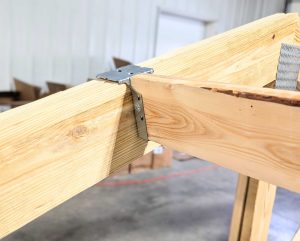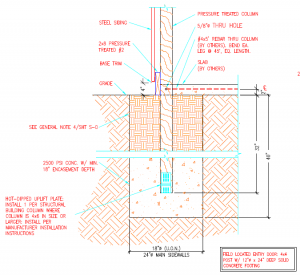 Pole buildings can be easily designed to withstand hurricane and tornado wind loads. The article below is from www.technewsdaily.com May 26,2011 and speaks to housing design under high winds.
Pole buildings can be easily designed to withstand hurricane and tornado wind loads. The article below is from www.technewsdaily.com May 26,2011 and speaks to housing design under high winds.
Redesigned Roofs Withstand High Wind Events
The tornado that stormed through Joplin, Mo., on May 22 shredded an estimated 8,000 buildings and stranded desperate families that now must decide whether to rebuild or find a new home. For those choosing to rebuild, Rima Taher, an expert on wind-resistant structures, has a bit of advice: don’t do it the old way.
“You wonder why we keep doing the same things, making the same buildings,” Taher told Innovation News Daily.
By analyzing debris from hurricanes, Taher has come up with a set of guidelines for building new homes in areas prone to extreme weather.
“There are similar problems. So, what usually works for tornadoes would work for hurricanes,” Taher said.
When wind hits, the roof provides the most critical defense. But during a hurricane or a tornado, the roof is often the first to go. Taher found that increasing the number of slopes on a roof improves the aerodynamics of the structure and greatly reduces the amount of pressure exerted on it. She recommended building a roof with at least four slopes, rather than a traditional gable roof that has only two.
As wind swirls around a house, it can push on the roof from both the inside and outside. Taher suggested installing a moveable flap close to the seam of the roof. During hurricanes and tornadoes, the flap would open, stabilizing the air pressure. In hot weather, the flap would provide ventilation.
Taher also recommended spending a bit of extra money on hurricane clips that attach the roof more firmly to the walls than nails or staples alone.
Researchers at the Center for Building Science and Technology in France tested the recommendations by placing wooden models in a wind tunnel and used the results to design a “cyclonic home” that has twice the wind resistance a traditional home.
Moreover, most of the suggestions are simple to execute and well worth the investment.
“A lot of the things we suggest don’t really cost a lot of money. The expense is really minimal compared to the benefits,” Taher said.
Applying modern technology to pole building design, the roof trusses are directly connected to the columns, which are embedded in the ground. Rather than even depending upon light gauge “hurricane” clips for wind uplift resistance, seven gauge steel plates, attached with 5/8 inch diameter through bolts can create a positive anchorage between the roof and the walls. Low cost ventilated ridge caps help to equalize internal and external pressures, to relieve some of the uplift forces. Pole buildings can also be easily designed with roof systems having gables or hips in multiple directions to improve aerodynamics.
Hansen Buildings provides custom designs, including multiple gables, hips or other features to increase wind uplift resistance. Alternate designs, using T’s, L’s, gables and just about any design you can think of is possible. My feeling is, if a pole building can be structurally designed to meet code, we will find a way to produce the pole building kit!










Installing flaps on the roof to stabilize pressure is an interesting idea. We agree that you can’t build your home the same way. Technology, building materials and design ideas are constantly changing, so if you do need to rebuild you can make many improvements to your home. We’ll definitely have to consider your ideas when working on roofs to withstand natural disasters!
There has been so much research done in the past few years on how wind affects structures. Modern technology allows for design solutions which just were not available to prior generations.
I really enjoyed this site, this is great blog.
I would offer some caution about your statements regarding wind forces, and designing for them. Designing any type of structure to resist F5 tornado forces is not ‘easy’; the forces generated by that type of event are enormous. Consider what goes into building a safe room, then extrapolate that to an entire house. The idea of equalizing pressure with some type of flaps is nice, until the flaps rip off the building and become deadly debris; the connections become extremely important. I also caution about the assertion that the roof is most critical. Wall failures, door failures, window failures, are critical considerations in the ability of a structure to survive a high-wind event.
The ability of foundations to resist uplift forces is also critical, and something I think pole buildings are at a disadvantage because they generally lack the foundation mass that conventional buildings possess.
It is also important to understand that the dynamics of a tornado are different than those of a hurricane, even if the wind speeds are similar.
Mr. Gold ~
Thank you very much for your comments. We do not mean to suggest design for these types of forces are “easy” and certainly not to be taken lightly. Post frame construction does lend itself to resistance of loads which other types of structures may have issues with – especially when it comes to high wind situations. Foundation mass is rarely going to be the cause of a building failure due to high wind speeds – inadequate connections as well as failure to design around the capabilities of openings are most usually the culprits.
Best regards ~ Mike
I’m curious to know if y’all can do Quonset style roofs on your buildings. I’m trying to figure out a way for the roof on a barn to be more wind friendly, during hurricanes. I’m thinking of using two 40’ conex containers parallel to each other, needing a span of 36’ between them. An arched style roof would offer less resistance. Combined with the stability of the containers, it should make for a pretty substantial structure. Are your buildings/components windstorm certified, for the Gulf Coast of Texas ? 77515 zip code.
Thanks.
We do not provide Quonset buildings. For what you have in mind, you should be involving a RDP (Registered Design Professional – engineer or architect) who can design an adequate hold down for the containers, regardless of what you intend to do for a roof. A gabled roof will offer less wind resistance than a quonset as it is the overall height of the roof which determines the applied wind force.
We can provide engineered designs for any design wind speed, including the Texas Gulf Coast.
Is this article saying not to attach post to concrete anchors, and to bury them instead for better wind support? Thanks
Properly embedded columns are far superior in resistance to wind, than bracket mounted columns.